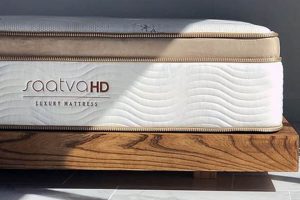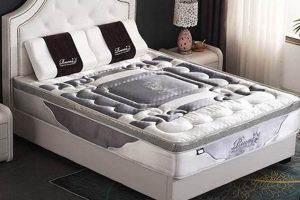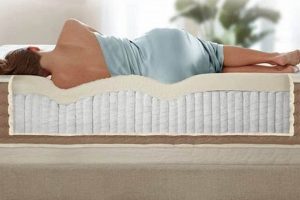A yielding layer placed atop a mattress, crafted primarily from the sap of rubber trees processed into foam, modifies the sleep surface. These products offer enhanced comfort, support, or temperature regulation. For instance, a firmer mattress can be softened, or an older mattress may gain renewed support through the addition of such a layer.
The increasing adoption of these sleep accessories stems from their ability to address specific comfort preferences or extend the lifespan of an existing mattress at a lower cost than full replacement. Their inherent elasticity and breathability contribute to pressure relief and a cooler sleeping environment, respectively. Natural origins appeal to consumers seeking eco-conscious and hypoallergenic bedding solutions.
The ensuing discussion will delve into the attributes that define superior options, including material density, firmness levels, construction methods, and certifications, providing readers with a framework for informed decision-making when selecting a mattress enhancement to optimize sleep quality.
Guidance on Selecting Superior Latex Mattress Overlays
Optimal selection requires careful consideration of several key factors. The following guidelines aid in making an informed decision.
Tip 1: Prioritize Density: Higher density indicates increased durability and support. Lower density options may degrade more quickly and offer insufficient pressure relief.
Tip 2: Assess Firmness Level: Consider personal sleep preferences and body weight. Side sleepers often benefit from softer options, while back and stomach sleepers may require firmer support.
Tip 3: Examine Construction: Dunlop and Talalay are common processing methods. Dunlop tends to be denser and more supportive, whereas Talalay is generally softer and more breathable. Research the differences to align with individual needs.
Tip 4: Verify Certifications: Look for certifications such as Oeko-Tex or GOLS to ensure the product is free from harmful substances and manufactured using environmentally sound practices.
Tip 5: Investigate Natural vs. Synthetic Composition: Natural versions offer superior breathability and hypoallergenic properties, but may come at a higher price point. Synthetic blends can be a more affordable alternative.
Tip 6: Consider Thickness: Thickness influences the degree of comfort and support. A thicker overlay provides more cushioning, but may alter the feel of the mattress significantly.
These considerations allow for a greater chance of choosing a sleep surface enhancement that improves sleep quality and extends the lifespan of the underlying mattress.
The subsequent sections will elaborate on specific product characteristics and maintenance procedures, further empowering readers to make well-informed choices.
1. Material Density
Material density, quantified as mass per unit volume, stands as a critical determinant of performance in yielding sleep surface enhancements. Its influence spans durability, support, and overall comfort, directly affecting the product’s suitability for diverse user needs.
- Longevity and Durability
Higher density typically corresponds to increased resistance against compression and degradation. A denser material retains its shape and supportive qualities for an extended period, leading to a longer lifespan. Conversely, lower density foams are more susceptible to sagging and premature wear, diminishing the overall value proposition.
- Support and Pressure Relief
The capacity of the material to provide consistent support and alleviate pressure points is intrinsically linked to its density. Denser materials distribute weight more evenly, minimizing localized pressure and promoting spinal alignment. Inadequate density may result in concentrated pressure, leading to discomfort and potential sleep disturbances.
- Responsiveness and Feel
Density impacts the responsiveness or “bounce” of the sleep surface. Higher density versions generally exhibit a more supportive and less conforming feel. Lower density options tend to be more contouring but may lack sufficient support for heavier individuals or those requiring firmer support.
- Weight and Handling
Density affects the overall weight, which influences ease of handling and installation. Denser options can be more cumbersome to move or adjust on the mattress. This consideration may be relevant for individuals with mobility limitations or those who frequently reposition their bedding.
In summary, density represents a pivotal performance parameter for latex mattress enhancers. Careful evaluation of this characteristic allows consumers to align product selection with individual comfort preferences, body weight, and desired levels of support and durability, facilitating a more satisfying sleep experience.
2. Firmness Options
Firmness, denoting the degree of give in a sleep surface, constitutes a critical element in the selection of yielding latex mattress enhancers. This attribute directly influences spinal alignment, pressure relief, and overall sleep comfort. The availability of diverse firmness choices allows consumers to customize their sleep experience, addressing individual needs and preferences effectively. For example, individuals experiencing back pain may benefit from a firmer option providing enhanced support, while side sleepers often require a softer surface to alleviate pressure on the shoulders and hips. Thus, the range of firmness options fundamentally contributes to the quality and suitability of any mattress enhancement.
The classification of firmness typically ranges from very soft to very firm, often employing a numerical scale for clarity. A softer choice conforms more closely to the body, promoting pressure relief. A firmer choice provides increased support, minimizing sinkage and maintaining spinal alignment, particularly beneficial for those with higher body weight. Medium-firm options offer a compromise, balancing support and pressure relief for a wider range of sleepers. Retailers frequently provide descriptions and, where available, standardized firmness ratings to assist consumers in making informed choices. The practical application of this understanding involves carefully assessing one’s typical sleep position, body weight, and any existing physical discomforts to determine the most appropriate firmness level.
The presence of varied firmness levels directly affects the effectiveness of a latex mattress enhancement in improving sleep quality. Inappropriate firmness can exacerbate existing discomforts or lead to new ones. Understanding the interplay between firmness, sleep position, and body weight facilitates the selection of a product that promotes proper spinal alignment, reduces pressure points,
and enhances overall sleep experience. This ultimately allows individuals to select yielding mattress toppers that best suit their individual needs and comfort requirements.
3. Construction Method
The term “construction method,” when discussing yielding sleep surface enhancements, directly correlates with the resultant properties and overall quality. Predominantly, latex toppers employ either the Dunlop or Talalay process, each imparting distinct characteristics affecting support, comfort, and durability. Dunlop involves pouring the latex compound into a mold, baking it, and resulting in a denser, firmer product. This process inherently creates variations in density, with the bottom typically being firmer than the top. Talalay, conversely, incorporates a vacuum and flash-freezing stage, yielding a more uniform, softer material. The choice of method thus significantly influences the tactile experience and support offered by the topper. For instance, a Dunlop construction may suit individuals requiring robust lumbar support, whereas a Talalay topper may be preferable for those seeking a plusher feel.
The practical significance of understanding these construction methods lies in aligning the topper’s properties with individual sleep needs. Incorrect selection can negate the intended benefits. A person requiring firm support who selects a Talalay topper may experience insufficient spinal alignment, leading to discomfort. Conversely, someone seeking pressure relief who opts for a Dunlop topper may find it excessively firm. Therefore, considering the inherent properties conferred by each construction method is paramount in determining suitability. Some manufacturers may also blend the two processes or incorporate additional layers, further complicating the selection process. Scrutinizing the product specifications and understanding the construction details are essential steps in making an informed decision.
In summary, the construction method represents a fundamental determinant of the performance characteristics of latex toppers. Distinguishing between Dunlop and Talalay processes, and considering their respective impacts on density, firmness, and overall feel, is crucial for consumers aiming to optimize their sleep environment. The inherent properties imparted by each method directly influence the ability of the topper to deliver adequate support, pressure relief, and long-term durability. Neglecting this aspect can lead to dissatisfaction and undermine the intended benefits of enhancing the existing mattress.
4. Certification Standards
Certification standards function as crucial indicators of quality, safety, and environmental responsibility in yielding sleep surface enhancements. For latex toppers, these standards verify the composition, purity, and manufacturing processes, influencing consumer perception and product selection. The presence of recognized certifications implies adherence to specific criteria, ensuring the absence of harmful substances and promoting environmentally sustainable practices. For example, the Oeko-Tex Standard 100 certifies that the product has been tested for harmful substances and is safe for human contact. Similarly, the Global Organic Latex Standard (GOLS) guarantees that the latex is sourced from organic plantations and manufactured according to stringent environmental and social criteria. Therefore, adhering to applicable certification standards greatly impacts the perceived quality and overall trustworthiness of best latex mattress toppers
The practical significance of certification lies in empowering consumers to make informed decisions. Certifications provide verifiable evidence regarding the product’s composition and potential impact on health and the environment. Without such assurances, consumers risk purchasing products containing harmful chemicals or sourced from unsustainable practices. For instance, a latex topper lacking GOLS certification may be derived from conventional rubber plantations employing environmentally damaging practices. The presence of these certifications offers assurance that the product aligns with consumer values regarding health, safety, and environmental stewardship. This is a very important part of finding the best latex mattress toppers.
In conclusion, certification standards are inextricably linked to the evaluation and selection of best latex mattress toppers. These standards offer verifiable benchmarks for quality, safety, and environmental responsibility. Consumers should prioritize products bearing recognized certifications to ensure they are purchasing safe, sustainable, and high-quality sleep surface enhancements. The absence of relevant certifications raises concerns about product composition, manufacturing practices, and potential health and environmental consequences. Choosing certified toppers contributes to both personal well-being and broader environmental protection efforts.
5. Thickness Variance
Thickness variance in yielding sleep surface enhancements critically affects performance and suitability. The dimension dictates the extent of comfort modification, support augmentation, and overall impact on the sleep experience. Different thicknesses cater to varying preferences and mattress conditions, directly influencing the efficacy of any latex topper.
- Degree of Comfort Alteration
Thicker toppers effect more pronounced changes to the feel of the underlying mattress. A thinner topper provides subtle adjustments, whereas a thicker variant significantly alters the surface contour and firmness. For example, a 2-inch topper offers moderate cushioning, while a 4-inch topper delivers a more substantial change, potentially transforming a firm mattress into a plusher surface. The implications involve carefully assessing the desired level of comfort modification before selecting a topper thickness.
- Level of Support Enhancement
The thickness correlates with the degree of support provided, particularly for heavier individuals or those seeking pressure relief. A thicker topper distributes weight more effectively, minimizing pressure points and promoting spinal alignment. Thinner toppers may lack sufficient material to provide adequate support for individuals with specific needs, such as those experiencing back pain. Consequently, thickness directly impacts the topper’s ability to alleviate discomfort and enhance sleep quality.
- Heat Retention Properties
Thickness influences heat retention, with thicker toppers potentially trapping more heat. Latex inherently exhibits breathability, but increased mass can still impede airflow. This consideration is particularly relevant for individuals prone to overheating during sleep. Thinner toppers offer better ventilation, minimizing heat buildup. Therefore, thickness must be balanced with considerations regarding temperature regulation.
- Mattress Compatibility and Fit
The thickness affects the overall height of the bed and the fit of sheets. A thicker topper adds substantial height, potentially requiring deeper-pocketed sheets. Moreover, an excessively thick topper may alter the perceived firmness and support characteristics of the underlying mattress
in unintended ways. Assessing mattress compatibility and sheet fit is therefore essential when selecting a topper thickness.
The preceding facets underscore the significant relationship between thickness variance and the selection of yielding sleep surface enhancements. Optimal choice necessitates careful consideration of comfort preferences, support requirements, heat retention properties, and mattress compatibility. Selecting an appropriate thickness maximizes the benefits of the topper and ensures a satisfactory sleep experience. Consumers should therefore evaluate these factors meticulously to align product selection with individual needs and mattress characteristics to identify the best latex mattress toppers.
Frequently Asked Questions Regarding Latex Mattress Enhancements
This section addresses common inquiries concerning latex mattress toppers, providing clarity on key aspects for informed decision-making.
Question 1: What differentiates natural and synthetic latex in mattress toppers?
Natural latex derives from rubber tree sap, exhibiting superior breathability, durability, and hypoallergenic properties. Synthetic latex is a petroleum-based product, typically less expensive but potentially lacking the benefits of its natural counterpart.
Question 2: How does density affect the performance of a latex mattress topper?
Density indicates the mass per unit volume. Higher density generally corresponds to increased support, durability, and resistance to compression. Lower density toppers may degrade more quickly and offer less substantial support.
Question 3: Which firmness level is most suitable for varying sleep positions?
Side sleepers often benefit from softer toppers that alleviate pressure on the shoulders and hips. Back and stomach sleepers typically require firmer support to maintain proper spinal alignment.
Question 4: What are the primary distinctions between Dunlop and Talalay latex?
Dunlop latex is denser and firmer due to its manufacturing process, which involves baking the latex directly in a mold. Talalay latex undergoes a vacuum and flash-freezing stage, resulting in a more uniform and softer feel.
Question 5: How do certifications ensure the quality and safety of latex toppers?
Certifications such as Oeko-Tex and GOLS verify that the product has been tested for harmful substances and manufactured according to environmentally sound practices, providing assurance of product safety and quality.
Question 6: How does the thickness of a latex topper impact its performance?
Thickness influences the extent of comfort modification, support augmentation, and overall alteration of the mattress feel. Thicker toppers offer greater cushioning, while thinner options provide more subtle adjustments.
Understanding these facets empowers consumers to select latex mattress toppers that align with their individual preferences, sleep needs, and health considerations.
The next segment will delve into the proper maintenance and care of latex mattress enhancers to prolong their lifespan and optimize performance.
Concluding Thoughts on Selecting Superior Latex Mattress Overlays
This exposition has systematically examined various facets impacting the selection of yielding sleep surface enhancements. Material density, firmness levels, construction methods, certification standards, and thickness variance all contribute significantly to the performance and suitability of best latex mattress toppers. A thorough understanding of these attributes empowers informed decision-making, aligning product choice with individual sleep preferences and needs.
The selection of sleep accessories warrants careful consideration. Factors discussed herein constitute a framework for evaluating options and prioritizing attributes most relevant to achieving optimal sleep quality and mattress longevity. Diligent research and informed selection contribute to a more restful and restorative sleep experience.


![Top-Rated: Best All Foam Mattress for Pain Relief [2024] Organic & Natural Mattress Buyer’s Guide: Non-Toxic Sleep Solutions Top-Rated: Best All Foam Mattress for Pain Relief [2024] | Organic & Natural Mattress Buyer’s Guide: Non-Toxic Sleep Solutions](https://mattressworldpa.com/wp-content/uploads/2025/07/th-7641-300x200.jpg)




![Top-Rated: Best Twin Size Air Mattress [Guide] Organic & Natural Mattress Buyer’s Guide: Non-Toxic Sleep Solutions Top-Rated: Best Twin Size Air Mattress [Guide] | Organic & Natural Mattress Buyer’s Guide: Non-Toxic Sleep Solutions](https://mattressworldpa.com/wp-content/uploads/2025/07/th-7636-300x200.jpg)